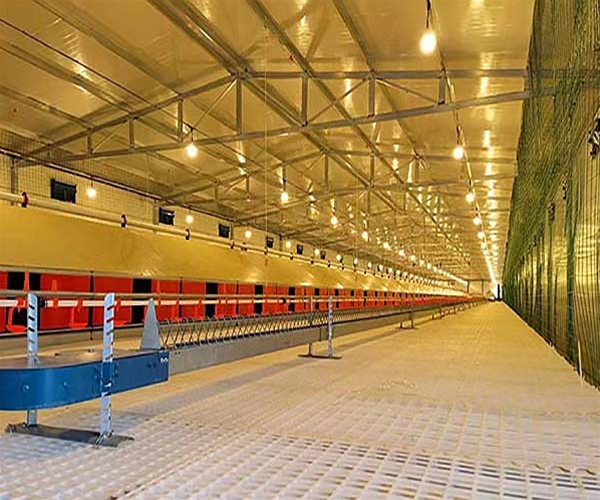Fully automated layer farming systems have become a key solution for improving production efficiency, lowering costs, and ensuring the health of poultry. In this article, we will share two success stories to demonstrate how fully automated layer farming systems can help farms enhance operational efficiency, reduce labor costs, and improve product quality while promoting sustainable farming practices.
Case Study 1: A Agricultural Cooperative – Boosting Productivity and Reducing Costs
Background:
A Agricultural Cooperative, located in Henan Province, is a large-scale egg production farm that supplies fresh eggs to the market. As the farm expanded, the traditional manual management model could no longer meet the growing demand for efficient production. Issues like feed waste, uneven feeding, and frequent manual cleaning were severely affecting both operational efficiency and profitability.
Solution:
After learning about the advantages of a fully automated layer farming system, A Agricultural Cooperative decided to implement this solution. The fully automated system includes automated feeding, watering, manure removal, and environmental control. Through real-time data monitoring, the system automatically adjusts temperature, humidity, and lighting conditions to ensure that the poultry are raised in the optimal environment.
Results:
After the implementation of the automation system, the cooperative saw significant improvements in various areas:
- Feed utilization increased by 25% thanks to the precise feeding system that ensures scheduled and proportional feed distribution, which also minimized waste.
- Egg production rose by 30%, as the health of the hens significantly improved, reducing the risk of diseases and mortality.
- Labor costs were reduced by 60%, as automation reduced reliance on manual labor, thus dramatically cutting down operational costs.
As a result, A Agricultural Cooperative not only increased its production but also strengthened its competitiveness in the market.
Case Study 2: B Ecological Farm – Transitioning from Traditional Farming to Green, Intelligent Automation
Background:
B Ecological Farm, located in Shandong Province, focuses on organic and free-range egg production. Although the farm utilizes free-range methods, it still faced many challenges in daily management. Issues such as feeding, watering, and cleaning required frequent manual intervention, resulting in resource wastage and added management pressure.
Solution:
B Ecological Farm decided to integrate a fully automated layer farming system, with an emphasis on environmental sustainability and efficiency. The system includes automated feeding, watering, manure removal, and intelligent environmental control, which adjusts temperature, humidity, and airflow based on real-time needs, ensuring that the hens are always in an ideal environment for growth.
Results:
The implementation of the system delivered the following key benefits:
- The health of the hens significantly improved, enhancing their immunity and reducing the need for medications and vaccinations.
- Egg production increased by 20%, with overall farming efficiency improving.
- Environmental impact was minimized, as the automated manure removal system reduced cleaning frequency and helped maintain a cleaner environment.
By adopting intelligent farming practices, B Ecological Farm successfully combined eco-friendly practices with high production efficiency while minimizing resource waste.
Advantages of a Fully Automated Layer Farming System
- Efficient Automation, Reducing Labor Costs
A fully automated layer farming system can handle tasks such as feeding, watering, and manure removal, reducing the need for manual labor and significantly lowering labor costs. Additionally, it improves the overall operational efficiency. - Precise Feeding and Watering, Optimizing Poultry Growth
The automated feeding and watering systems ensure that every hen receives the right amount of feed and water at the right time, promoting healthy growth, optimal egg production, and reducing waste. - Automatic Manure Removal, Maintaining Cleanliness
The built-in manure removal system regularly clears manure from the poultry house, keeping the environment hygienic and reducing the spread of diseases, ultimately improving the health and productivity of the hens. - Intelligent Environmental Control, Creating Ideal Growth Conditions
The automated environmental control system monitors and adjusts temperature, humidity, and ventilation in real-time to maintain the optimal environment for poultry growth, improving both health and productivity.
How to Choose the Right Fully Automated Layer Farming System?
When selecting the right fully automated layer farming system, factors such as farm size, budget, and required functionality should be considered. For smaller family farms, a basic automated feeding and watering system may suffice. However, larger commercial farms may require more complex systems that include environmental control and intelligent data analysis.
Conclusion: Driving the Smart Transformation of Modern Poultry Farming
Through the success stories of A Agricultural Cooperative and B Ecological Farm, it is evident that a fully automated layer farming system can significantly improve farm productivity, reduce labor costs, and enhance the health and environmental quality of poultry. Whether for small family farms or large commercial operations, the introduction of automation has become a key driver for increasing competitiveness and promoting sustainable farming practices.
As the poultry industry shifts toward more intelligent and eco-friendly practices, fully automated layer farming systems will continue to bring innovations and opportunities for the global agricultural industry. If you too wish to increase your farm’s efficiency, reduce costs, and ensure high-quality egg production, now is the time to explore our fully automated layer farming systems and take your farming business to new heights.

